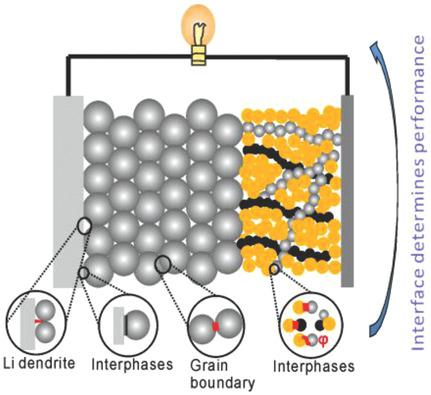当前位置:
X-MOL 学术
›
Adv. Funct. Mater.
›
论文详情
Our official English website, www.x-mol.net, welcomes your feedback! (Note: you will need to create a separate account there.)
Progress of the Interface Design in All‐Solid‐State Li–S Batteries
Advanced Functional Materials ( IF 19.0 ) Pub Date : 2018-03-08 , DOI: 10.1002/adfm.201707533 Junpei Yue 1 , Min Yan 1 , Ya-Xia Yin 1, 2 , Yu-Guo Guo 1, 2
Advanced Functional Materials ( IF 19.0 ) Pub Date : 2018-03-08 , DOI: 10.1002/adfm.201707533 Junpei Yue 1 , Min Yan 1 , Ya-Xia Yin 1, 2 , Yu-Guo Guo 1, 2
Affiliation

|
Lithium–sulfur (Li–S) batteries are one of the most promising next‐generation battery types for their high energy density and low cost. On the other hand, safety issues and poor cyclability strongly limit practical application. Solid‐state electrolytes (SSEs) can present as high ionic conductivity as aprotic electrolytes and eventually avoid the shuttle effect, which provides an ultimate solution for safe Li–S batteries with good cyclability. In this review, the recent achievements in all‐solid‐state Li–S batteries based on inorganic SSEs are summarized. Furthermore, the main attentions are paid to the interfaces, including metallic lithium|SSEs, SSEs|SSEs, and composite sulfur cathode|SSEs. The potential approaches to deal with these interfacial issues are proposed as well, such as composite SSEs with an asymmetric structure to enhance their compatibility with lithium anodes and sulfur cathodes, adding Li2O or LiF and increasing the densification to reduce the grain boundary resistance, and nanomaterials used to improve the kinetic process in cathode.
中文翻译:

全固态锂电池的界面设计进展
锂硫(Li–S)电池具有高能量密度和低成本,是最有希望的下一代电池类型之一。另一方面,安全性问题和差的可循环性强烈地限制了实际应用。固态电解质(SSE)可以像非质子电解质一样具有高离子电导率,并最终避免穿梭效应,这为具有良好可循环性的安全Li-S电池提供了最终解决方案。在这篇综述中,总结了基于无机SSE的全固态Li-S电池的最新成就。此外,主要关注界面,包括金属锂| SSE | SSE |和复合硫阴极| SSE。还提出了解决这些界面问题的潜在方法,2 O或LiF并增加致密化以降低晶界电阻,而纳米材料则用于改善阴极的动力学过程。
更新日期:2018-03-08
中文翻译:

全固态锂电池的界面设计进展
锂硫(Li–S)电池具有高能量密度和低成本,是最有希望的下一代电池类型之一。另一方面,安全性问题和差的可循环性强烈地限制了实际应用。固态电解质(SSE)可以像非质子电解质一样具有高离子电导率,并最终避免穿梭效应,这为具有良好可循环性的安全Li-S电池提供了最终解决方案。在这篇综述中,总结了基于无机SSE的全固态Li-S电池的最新成就。此外,主要关注界面,包括金属锂| SSE | SSE |和复合硫阴极| SSE。还提出了解决这些界面问题的潜在方法,2 O或LiF并增加致密化以降低晶界电阻,而纳米材料则用于改善阴极的动力学过程。

























 京公网安备 11010802027423号
京公网安备 11010802027423号